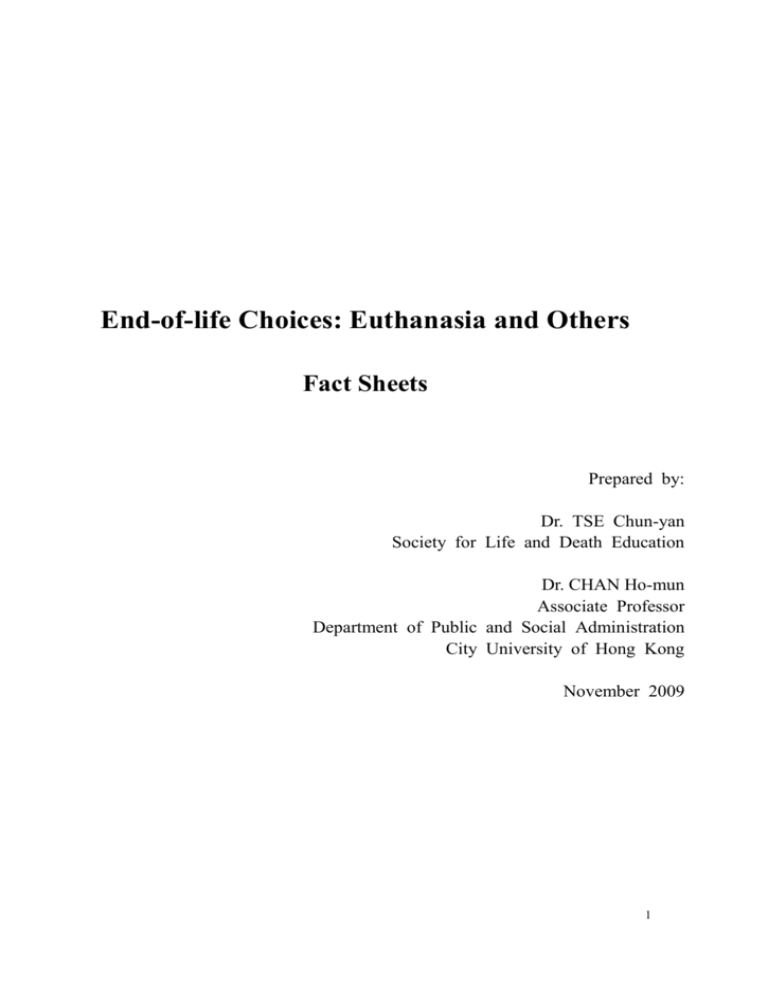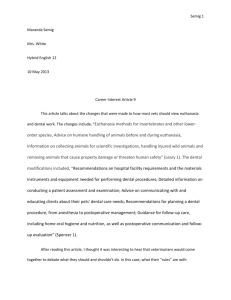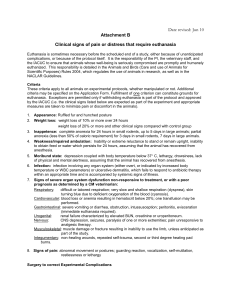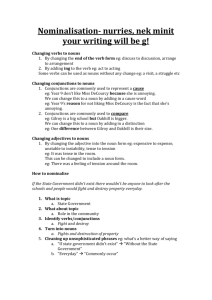Is Euthanasia an Answer
advertisement

End-of-life Choices: Euthanasia and Others Fact Sheets Prepared by: Dr. TSE Chun-yan Society for Life and Death Education Dr. CHAN Ho-mun Associate Professor Department of Public and Social Administration City University of Hong Kong November 2009 1 Fact Sheet 1 - Setting the scene: Euthanasia is a frequently debated issue in the community. However, there is often confusion in the concepts and terminologies involved. Different people have different definitions for the terms used in the discussion. Euthanasia could be defined narrowly or broadly. In the medical and legal field, when the term is used without qualification, euthanasia usually signifies “voluntary active euthanasia”. According to the Professional Code of Practice of the Medical Council of Hong Kong, euthanasia is defined as “direct intentional killing of a person as part of the medical care being offered”. Euthanasia is illegal throughout the world with the exception of Netherlands, Belgium and Luxembourg. However, in public debates and in bioethics literature, the term euthanasia often carries a broader meaning. Forgoing life-sustaining treatment (LST) is often considered as one form of euthanasia, labeled as “passive euthanasia”. Different ethicists define “passive euthanasia” differently. Some define the term as all forms of forgoing LST, while some define it as forgoing LST with the intention to shorten life. It should be noted that, legally and medically, forgoing LST is distinct from active euthanasia. The former, if carried out under appropriate circumstances (when it is the wish of a mentally competent patient or when the treatment is futile), is legally acceptable in most parts of the world including Hong Kong. To avoid any unnecessary confusing connotations, the term “passive euthanasia” is not recommended by the medical and legal field, and the term is not used in relevant guidelines and legislations in many western countries and Asian regions (including Hong Kong, Taiwan and Singapore) on the issue. Forgoing LST is itself a complex ethical issue, and what constitutes futility is not easy to define. Some situations are non-controversial, like forgoing cardiopulmonary resuscitation in a dying patient with advanced cancer, which is being practiced everyday in Hong Kong, whereas some situations are controversial, like the withdrawal of ventilator support in a conscious quadriplegic patient. It would not help public discussion if the term “passive euthanasia” is used indiscriminately without a clear definition, especially when non-controversial cases of forgoing LST are referred to as “euthanasia”. This may blur, for no good reason, the distinction between active euthanasia and forgoing futile LST which is a necessary sequel of advancement of medical technology. Without such forgoing, many dying patients would have to go through various meaningless futile treatments that only add suffering before they are certified dead. Since there is a distinction between forgoing futile LST and active euthanasia, the acceptance of former does not necessarily mean the acceptance of the latter. The terminology issue in the Chinese community is further compounded by the loose usage of the Chinese term 安樂死, which is sometimes used to describe the state of the dying process or even palliative or hospice care, besides euthanasia in the standard sense or forgoing LST. 2 Such a loose usage of the term euthanasia or 安樂死 leads to difficulties in public discussion. Public opinion in support of euthanasia may actually include support for forgoing futile LST and support for palliative care. This confusion is totally unnecessary and should be avoided. 3 Fact Sheet 2 - Forgoing life-sustaining treatment: Life-sustaining treatment (LST) refers to “all treatments that have the potential to postpone the patient’s death”. In appropriate circumstances, one may withhold or withdraw LST in order not to prolong the dying process. Forgoing LST could be appropriate when: 1. it is the wish of a mentally competent and properly informed patient, or 2. the treatment is considered futile. Respecting the wish of the patient involves the ethical principle of “autonomy”. The determination of futility involves the ethical principles of “non-maleficence” (do no harm) and “beneficence” (do good), balancing the burdens and benefits of the treatment towards the patient, and asking whether the treatment is in the best interests of the patient. This involves quality of life considerations and can be value-laden. The decision-making process in most cases is thus a consensus building process between the healthcare team and the patient and family. Forgoing futile LST implies the acceptance of the fact that human is mortal. This is medically and legally distinct from euthanasia, and is legally acceptable in most parts of the world including Hong Kong. Many medically advanced countries in the world have issued guidelines on this, and the Hospital Authority of Hong Kong has issued the guidelines in 2002. In Hong Kong, if the patient is not mentally competent and does not have a guardian, the doctor in-charge is legally responsible for making medical decisions based on the best interests of the patient. However, a decision on futility of LST should involve consensus building between the healthcare team and the family if possible. Sometimes, such decisions are difficult especially if the prior view of the patient is not known. In the recent years, the concepts of advance care planning and advance directives are promoted in various parts of the world, so that the wish of the patient could be made explicit before losing capacity. One should note that there are no legal or necessary morally relevant differences between withdrawing and withholding LST. Allowing withdrawal may safeguard those patients whose benefit from LST may appear uncertain at first. Though artificial nutrition and hydration is classified as medical treatment, the withdrawal of such is controversial except when death is imminent and inevitable, or it is the wish of a mentally competent patient. Forgoing LST in appropriate circumstances does not at all mean abandoning the patient. Basic care, symptom control, care and concern should always be offered. 4 Fact Sheet 3 – Euthanasia: I. Definitions: Euthanasia: Broad definition: the intentional killing of a patient, by act or omission, as part of the medical care. Narrower definition: same as “active euthanasia”. Narrowest definition: same as “voluntary active euthanasia”. Active euthanasia: The killing is achieved by a direct act to kill. Passive euthanasia: The killing is achieved by omission of treatment (Please refer to Fact Sheet 1 for a discussion on this terminology). Voluntary euthanasia: The killing is at the voluntary request of the patient. Non-voluntary euthanasia: The patient killed is either not capable of making the request, or has not done so. Involuntary euthanasia: The killing is against the wishes of the patient. II. Legal status: Euthanasia is illegal throughout the world with the exception of the Netherlands, Belgium and Luxembourg, where active voluntary euthanasia has been legalized since 2002, 2002 and 2009 respectively. Additionally, physician assisted suicide has been legally permitted in Oregon State and Washington State of USA since 1997 and 2009 respectively. On the other hand, for many years, Switzerland has allowed assisted suicide (not necessarily physician assisted) based on altruistic motives. III. Situation in the Netherlands: In the 1990s, the public prosecutor in the Netherlands would not prosecute physicians for euthanasia if they have adhered to a number of requirements. In 2002, the Euthanasia Act was passed. The Act allows euthanasia in patients with “no prospect of improvement, and were experiencing unbearable suffering”.1 In 2001 and 2005, 2.8 and 1.8 deaths out of 100 deaths respectively were the result of euthanasia (and assisted suicide) in the Netherlands.2 1 One should note that the patient eligible for euthanasia in the Netherlands is not necessarily terminally ill, nor suffering from physical pain. More details of the law could be found in http://english.justitie.nl/currenttopics/pressreleases/archives2002/-euthanasia-and-assisted-suicide-contr ol-act-takes-effect-on--april-.aspx 2 Van der Heide, Agnes, et al. 2007. “End-of-Life Practices in the Netherlands under the Euthanasia Act.” New England Journal of Medicine 356:1957-1965. 5 IV. Reasons supporting the legalization of voluntary active euthanasia: 1. 2. 3. 4. One should respect the patient’s personal choice to end his/her life to relieve his/her suffering. There are hard cases in which the unbearable pain and suffering of a patient cannot be effectively alleviated by pain management, forgoing burdensome/futile LST, and palliative care. Active euthanasia may well be the last resort. The value of human life is duly respected if active euthanasia must be voluntary and used only as a last resort for hard cases. Some patients could not kill themselves even with the assistance of a physician while many others could. It seems unfair if they are deprived of the option of euthanasia. V. Reasons against the legalization of euthanasia: 1. With modern palliative care, pain and suffering of the great majority of patients can be controlled. In many situations, a request for euthanasia is a request for relief of symptoms. 2. 3. Licensing killing in non-war situations has significant impact on societal values. There could be implicit pressure on the chronically ill and the vulnerable groups to choose euthanasia, especially in a Chinese society like Hong Kong. There may be negative implication on resource allocation to the chronically ill and terminally ill. There could be the “slippery slope” once the barrier to euthanasia is broken. Abuses are prone to occur because it is difficult to ascertain that the request for euthanasia is entirely voluntary and no better alternative is available. There is also worry that legalization of voluntary active euthanasia 4. 5. may subsequently lead to acceptance of non-voluntary active euthanasia in practice. That has already happened in the Netherlands. 6 Fact Sheet 4 – Advance directives: An advance directive is an expression of how a patient wishes to be treated when s/he becomes mentally incapacitated. There are two kinds of advance directives: 1. An instructional directive (a living will) usually comprises of instructions about what kind of LST that a patient wishes to refuse when s/he becomes mentally incapacitated under some specified circumstances. An instructional directive is valid if its instructions are clear and if the patient is mentally competent and understands the consequence of the instruction at the time of making the directive. A valid instructional directive refusing LST is legally binding in Hong Kong, and should be followed if the directive is applicable to the clinical situation faced. In some jurisdictions, especially in the USA, patients may express their wishes to prolong their lives to the greatest possible extent when s/he lapses into mental incompetency. Yet this practice is not widely accepted in jurisdictions outside the US. 2. A proxy directive (durable/lasting power of attorney for healthcare) expresses the patient’s wish to appoint another person, usually a family member, to make healthcare decisions on his/her behalf when s/he becomes mentally incapacitated under some specified circumstances. A proxy directive is not legally binding in Hong Kong even if it is valid, but that’s not the case in some other jurisdictions, including USA, and some territories in Australia. UK also recently changed the law to allow this. In Hong Kong, the term ‘advance directive’ is usually used in a narrow sense to mean an instructional directive for the refusal of LST. This usage will be followed in this fact sheet. The legal force of a valid advance directive indeed stems from a respect of the autonomy and the bodily integrity of the patient. Treatment against the wishes of a patient could be regarded as an assault or a battery which is a criminal offence. In determining whether a treatment is worthwhile, one needs to weigh its burdens and benefits for the patient. A treatment is burdensome or futile and therefore not in the best interests of the patient if its burdens outweigh its benefits. Yet, as we have seen in Fact Sheet 2, very often the weighing could not be done properly without taking the wishes of the patient into consideration. Advance directives are useful tools for healthcare professionals to understand and ascertain the wishes of the patient, and so can serve to promote patient’s best interests. Advance directives are seldom practiced in Hong Kong. The Law Reform Commission of Hong Kong has recommended in 2006 that the concept of advance directives should be promoted in Hong Kong by non-legislative means. 7 It should be noted that an advance directive is only a legal tool to document the decision of the patient to refuse certain LST. In patients faced with an incurable disease, this should be part of “advance care planning”, which is the process of communication among the patient, the family members and the healthcare team to allow improved understanding, reflection and decision-making regarding end-of-life care. 8 Reference list: Basic Readings: 1. Albom, Mitch. 1997. Tuesdays with Morrie: An Old Man, a Young Man, and Life's Greatest Lesson. New York : Doubleday. Albom, Mitch. 1997/2004. 白裕承譯. 最後 14 堂星期二的課. 台北: 大塊文化 出版股份有限公司. 2. Chan, Ho Mun. 2006. “Euthanasia: Can Life Become not Worth Living?” In Meaning of Life, edited by Julia Tao and Hektor K. T. Yan, 263-282. Singapore: McGraw-Hill Education (Asia). 3. Hospital Authority Clinical Ethics Committee. 2002. HA Guidelines on Life-sustaining Treatment in the Terminally Ill, http://www.ha.org.hk/visitor/ha_visitor_index.asp?Content_ID=363&Dimension= 100&Lang=ENG. 4. Tse, Chun Yan, and Samantha Mei Chi Pang. 2006. "Euthanasia and Forgoing Life-sustaining Treatment in the Chinese Context." In Death, Dying and Bereavement: A Hong Kong Chinese Experience, edited by Cecilia Chan and Amy Chow, 169-181. Hong Kong: Hong Kong University Press. 5. 斌仔. 2007. 我要安樂死. 香港: 三聯書店. 6. 路向四肢傷殘人士協會. 2009. 路向四肢傷殘人士協會網頁, http://www.4limb.org/view/news.0. Further Readings: 1. Keown, John. 2002. Euthanasia, Ethics and Public Policy: An Argument against Legalisaion. Cambridge: Cambridge University Press. 2. Warnock, Mary, and Elisabeth Macdonald. 2008. Easeful Death: Is there a Case of Assisted Dying? Oxford: Oxford University Press. 9





